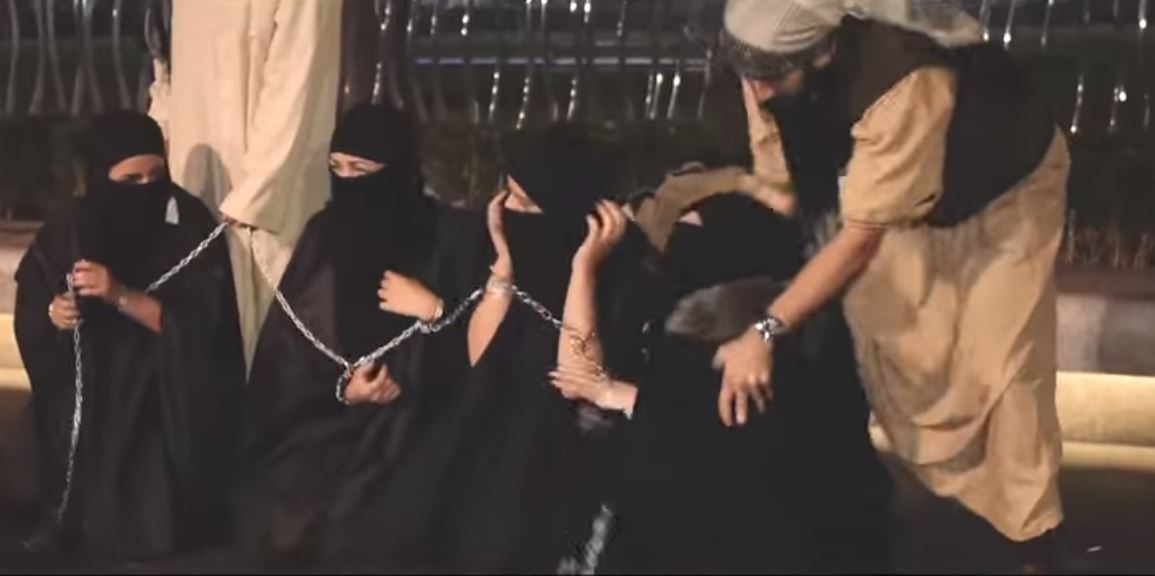Nearly a year ago, a beautiful young woman was bought from a cage set up by the ISIS terrorists on the left side of beheading cage approximately 75 meter to the west of the main gate of the National Museum in Palmyra.
This woman, 18, was walking this month with a sunburned baby in her hand but with no luggage or even purse on Homs-Palmyra highway hoping to find a place to stay, according to an article written by the U.S. Professor Franklin Lamb under the title ‘ Driven into the desert, Daesh (ISIS) barbarity still haunts Palmyra’
The writer was told that ISIS employed auctions selling the women to the highest bidder. “the price was around $ 200 for each female. Daesh demanded payment in USD. One 12 old girl was sold, according to an eyewitness, for $100 dollars. Another ‘‘slave’’ woman, reportedly a particularly attractive blue eyed occidental looking blond sold for the high price of $400, although the vendor had wanted $ 500 for her.”
“Since the average salary for ISIS fighters serving in Palmyra was close to $ 400 monthly, or roughly four times what many government, army and others earn here, many fighters, particularly foreign fighters I was told, bought women and took them to the Guest House among the ruins or to the nearby Zenobia Hotel or a couple of others where many fighters lived. Others took them up to the Roman Citadel above Palmyra. For more security, many Daesh fighters preferred to live at the Citadel on the hill. The same preference that led ‘rebels’ to take over the medieval fortress of Crac des Chevaliers, 200 km to the west with its impenetrable ten foot thick walls,” Prof. Lamb added.
Survivors
He quoted eyewitnesses as saying: “Sometimes when terrified slave women were caged next to beheading chamber, they were spattered with blood.”
Those slave women are sold again or simply abandoned when ISIS terrorists retreat from an area as they do not want the burden of taking slave women with them.
The surviving slave women in Palmyra as elsewhere become ‘untouchables’ without much of a future, the professor stressed, indicating that around 1000 of the Palmyra’s original population of 170.000 are back.
” A few return every day now. Most had fled while approximately 15,000 remained when Daesh occupied the town. When the army arrived on March 27, 2016, ISIS ordered all the residents to leave and they took them into the desert without any shelter. It is still not known for sure what became of them. Some relatives continue to seek information about any survivors,” Prof. Lamb stressed.
ISIS culture
 He, in addition, was briefed on many aspects of the Daesh culture and how they operate militarily sometimes affected by tensions within their ranks stemming from rampant drug use and problems among the foreign fighters who continue to arrive to Syria.
He, in addition, was briefed on many aspects of the Daesh culture and how they operate militarily sometimes affected by tensions within their ranks stemming from rampant drug use and problems among the foreign fighters who continue to arrive to Syria.
“Daesh Emirs interpret the Koran to be based on an eye for and eye etc. Since pilots drop bombs and fire air to ground rockets, which bring fire on its victims, the Koran (according to Daesh pervert reasoning) requires the pilots be burned alive,” the professor said, confirming that ISIS’s trials offer zero due process.
” Every accused person who appeared before the Daesh court in Palmyra was found guilty. When sentence was passed for a capital offence, of which there were many, the convict was often immediately marched outside the main gate the National Museum and led maybe fifty yards to the left to the beheading cage.”
ISIS living quarters
Moreover, the professor visited the ISIS living quarters in many rooms of the Government Guest House near the Temple of Bel and also at the Zenobia Hotel.
He saw plenty of tins of spicy canned sardines scattered here and there as well as those easy-to-cook packs of noodles, as well as packages of processed cheese wedges. Large pots, however, suggest that more elaborate meals were also prepared.
“Muslims tend to be very clean people. But not this bunch! Filthy toilets and trash everywhere. Piles of dirty clothes, sheets and blankets that appear and smell like they have never been washed. Lots of captagon pills lying around (known among locals as “Daesh milk and honey”) and tubes of something labeled Hiler Herbal Cream were in many rooms. One local speculated that Daesh concocted a captagon ointment paste to apply to specific body parts employed while assaulting “slave” women,” the professor affirmed.
On March 27th, the approximately 1.500 ISIS terrorists, who occupied Palmyra for nearly ten months reportedly split roughly into thirds and headed to Aleppo, Deir Ezzour and Raqqa where they are now fighting.
Basma Qaddour

